IPA Clone Series: Firestone Walker Union Jack
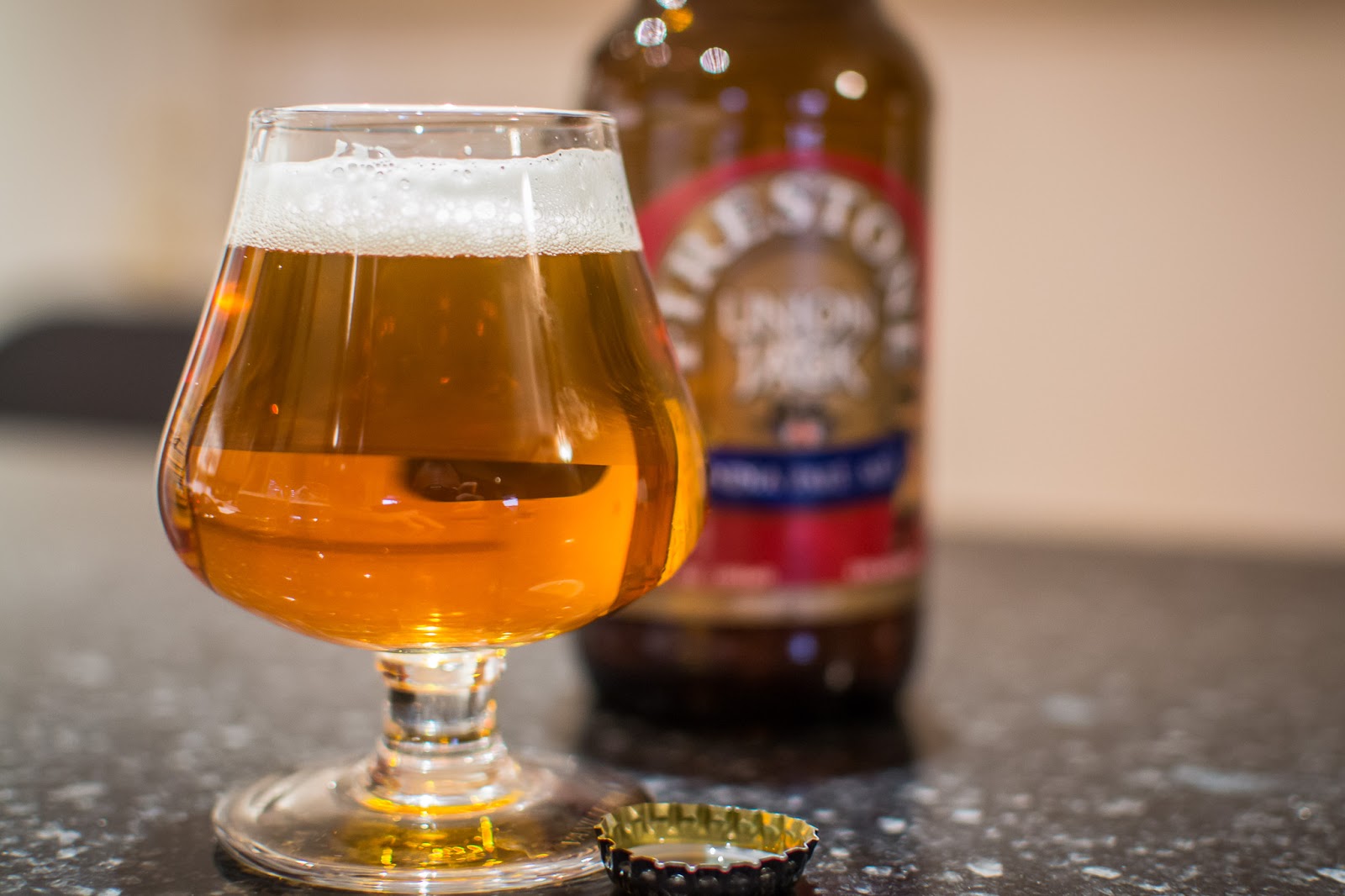
Union Jack. Probably my favorite beer in the country. It’s over-the-top hoppy, but in a floral and sweet citrus sort of way. It has a big malty flavor, but it isn’t cloying in the slightest. I just love this beer. It unfortunately gets me in trouble because I have a habit of drinking it like it’s going out of style, but that’s another story.
In terms of my little IPA Clone Series, I saved this beer for last because I figured it would be an absolute slam dunk. The boys over at the Brewing Network brewed a clone about two years ago, and according to them, it was so unbelievably cloned, it was the same beer. I figured this recipe would be a cake walk.
The funny story with the Union Jack recipe is, every time I visit the Firestone website, there is a slightly different dry hop listed. Roughly 12 months ago, it was Cascade, Centennial, Amarillo, and Simcoe. Around 4-6 months ago Chinook was added, and now Citra is listed. I’m scratching my head, thinking: Is Brylindson adding new hops to blend for flavor consistency? Or is he playing around with the recipe, looking for a slightly new aroma?
I have to imagine it would be for consistency, as commercial breweries endlessly tweak recipes to account for changes in hops and grain. Since both are agricultural products, they can vary year to year. To keep the end product tasting the same, changes are inevitable. Citra just strikes me as so odd though, since nothing smells like Citra, other than…. Citra. Galaxy is the only Citra-ish hop that comes to mind, but none of the hops in Union Jack have that quality. So the only way to sort out this mess was to track down a super fresh bottle of Union Jack and decide for myself.
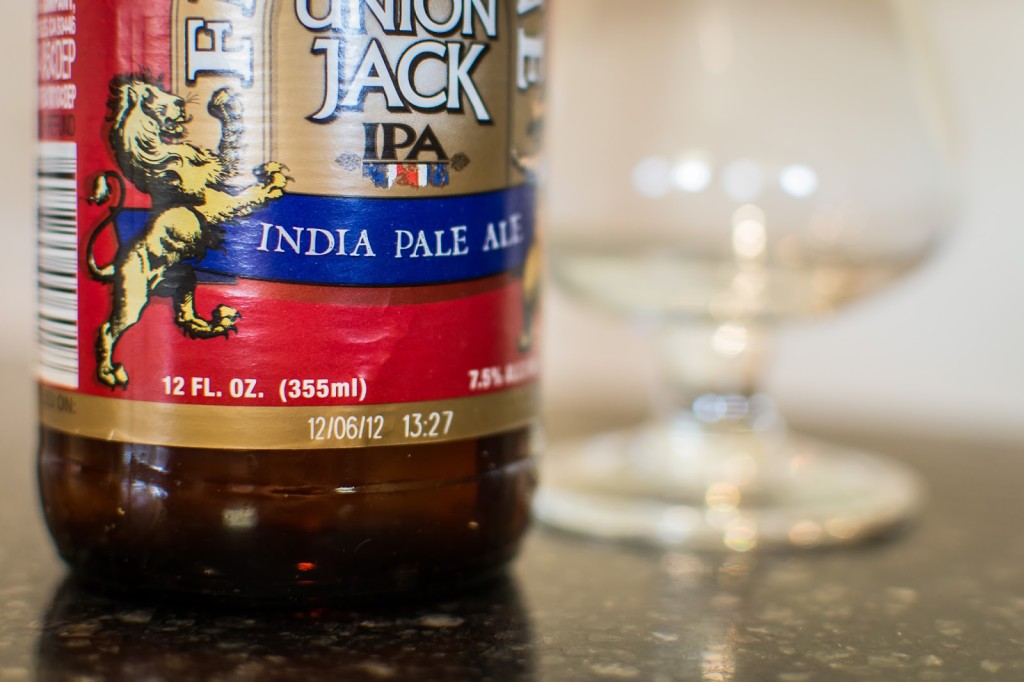 After looking around town, I found a six pack that was under a month old; yep, that’ll do. Conveniently, I have one beer carbonating, and another in the secondary that were both dry hopped with Citra. I grabbed some snifters, and sat down to compare them.
After looking around town, I found a six pack that was under a month old; yep, that’ll do. Conveniently, I have one beer carbonating, and another in the secondary that were both dry hopped with Citra. I grabbed some snifters, and sat down to compare them.
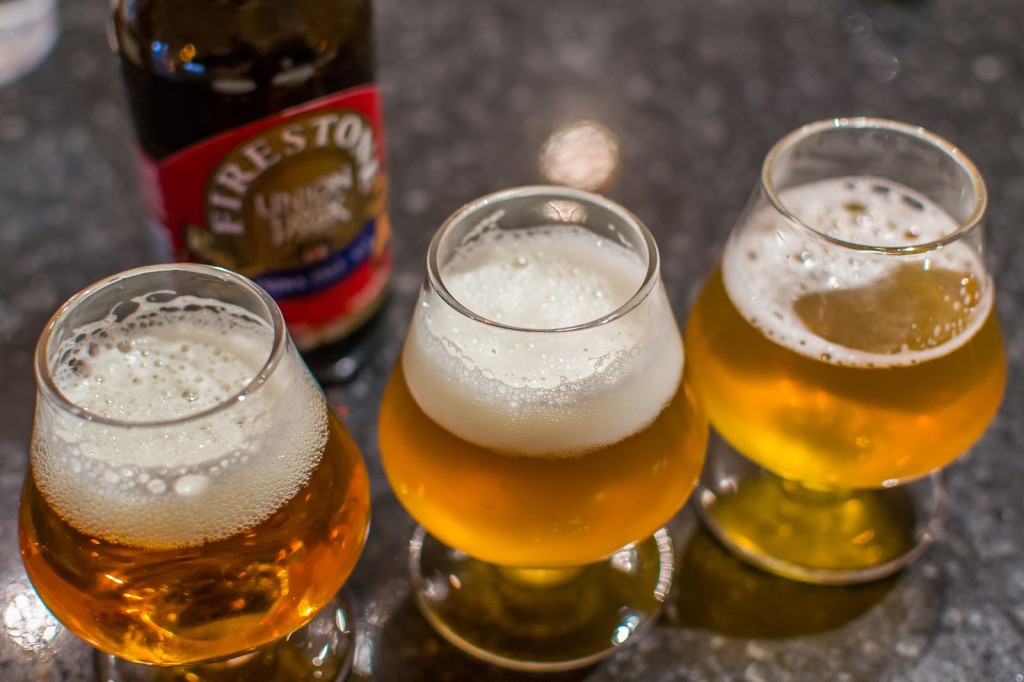 UJ tastes just like I remember. There’s a big citrus aroma, tons of grapefruit, and some floral qualities. It’s almost hand-soap like, in the best way possible (I have no idea how to make that sound appealing.)
UJ tastes just like I remember. There’s a big citrus aroma, tons of grapefruit, and some floral qualities. It’s almost hand-soap like, in the best way possible (I have no idea how to make that sound appealing.)
Both Citra beers reek of over-ripe mango. From experience, I know that fades some, but I’m not getting that character in the slightest from UJ. So I have no idea what to make of the dry hops listed on the website. I guess I’ll throw in a splash (.25oz) of Citra just to satisfy my curiosity. That’s a drop in a bucket considering there’s 6.5oz of dry hops, but it’ll make me feel better =)
I’m brewing this beer right on the coat-tails of my last batch to advantage of the fresh pitch of WLP002 I had from the Standard Bitter I kegged 5 days prior. There’s not too much to report about the brew day, other than it went much smoother than my last. I remembered the acid malt and whirlfloc, and it was much more stress-free. 60min mash @ 145*, 5min to ramp to 155*, then I held for 10min at 155*. I boiled for 90min, whirlpooled the hops hot for 20 minutes before I chilled to 62F. One thing to note about this beer, is that it definitely makes for a longer brew day. The mash takes 20min longer than normal, the boil is 30min longer, and the whirlpool adds another 20min. It was a solid 5.5hr brew day for me (typically 4 flat).
Anyway, I added O2, pitched the yeast, and set the fridge at 18C. WLP002 fermented out quickly as it always does, and I raised the temp to 20C once it started to slow down.
Brewed: 01-22-13
Dry Hopped: 01-25-13
Kegged: 02-06-13
OG: 1.071
FG: 1.011
ABV: 7.8%
IBU: ~70
6 gallons
12.5lbs 2-Row
2lbs Munich
10oz Carapils
3.5oz Carastan
Mash @ 145 for 60 min then 155F for 10 min
1oz Apollo @ 90
.75oz ea Centennial/Cascade @ 30
2oz ea Centennial/Cascade @ 0
WLP002 – English Ale Yeast – Repitched from Bitter
Dry Hop 1: 1.5oz ea Centennial/Cascade + .25oz ea Citra/Chinook
Dry Hop 2: 1oz ea Centennial/Cascade + .5oz ea Amarillo/Simcoe
3-4 days per addition
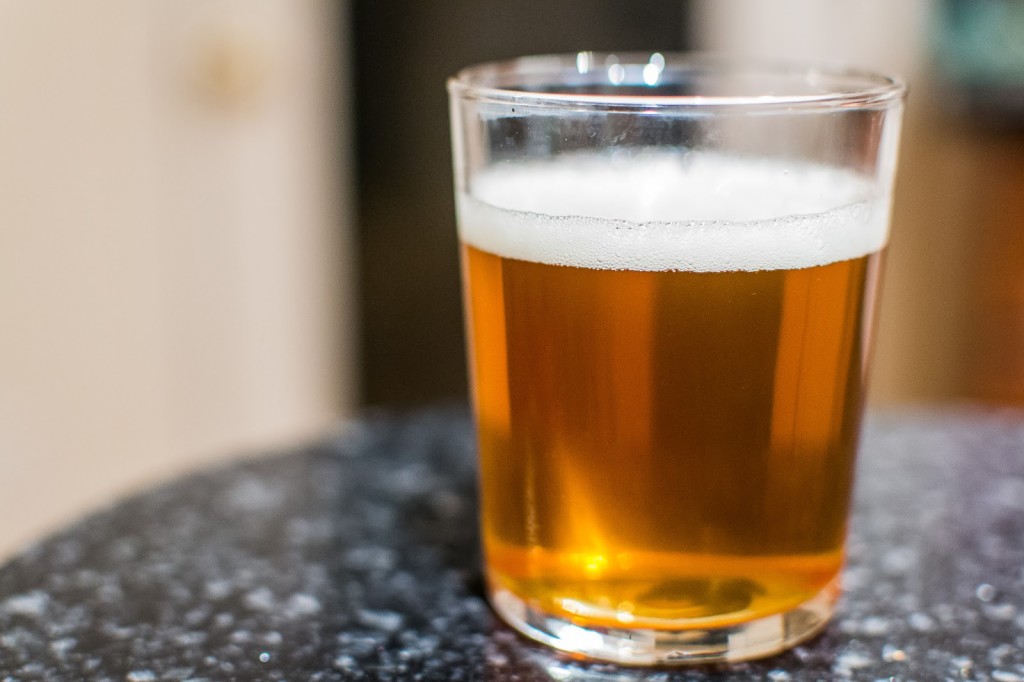 Fast ferment here. On Day 4 we were at 1.019, so I added the first dose of dry hops. It hit FG on day 6 or so. I racked to secondary after 8 days, and hit the beer with the second dose of dry hops. Those hops sat 4 days warm, then I crashed the secondary in the fridge. When I went to keg the beer, I was in for a bit of a surprise, but we’ll get to that below.
Fast ferment here. On Day 4 we were at 1.019, so I added the first dose of dry hops. It hit FG on day 6 or so. I racked to secondary after 8 days, and hit the beer with the second dose of dry hops. Those hops sat 4 days warm, then I crashed the secondary in the fridge. When I went to keg the beer, I was in for a bit of a surprise, but we’ll get to that below.
This beer did over-attenuate a bit, which my Double Jack clone did as well. I might need to tweak the mash temp a little for the 2-row I’m using. Either way, a couple points aren’t a huge deal here. What was a big deal, was my choice to let the secondary crash with too much head-space for 3-4 days. Oxidized.
I normally secondary my IPAs in a better bottle with very little head space. I’ll then cold crash them for 18-24hrs, just long enough for the hops to drop to the bottom. My better bottle was tied up, so I racked this beer into a 6.5gal bucket, which left 2+ gal of head space. I crashed the beer in the fridge, and was too busy all week to keg it. Big mistake. In the 4 days from crashing it, to kegging it, it oxidized. Bad. The beer just reeks with that sweet, toffee-caramel-candy flavor of oxidized American hops. It tasted perfect 4 days prior. Fuck.
I went ahead and kegged the beer, but after roughly two weeks, it’s clear that it isn’t getting better. I’m pretty let down, but there’s some lessons to be learned. IPAs oxidize easily. Headspace is a big deal when you crash the fermenter, as the cold beer will take in gases more readily. Finally, I’m going to start using corny kegs as secondaries, as they are air tight and can be easily flushed with CO2. I’ll probably get around to re-brewing this again sometime during summer. For now I’ve got some other beers planned, and I’d rather forget about having to dump this batch for now. (Fuck.)
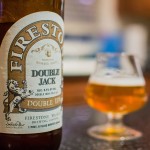



I don't know how I stumbled upon your blog, but I absolutely love it. I feel like I'm learning more from your posts than any other media form (books, podcast, internet, etc…) Really sorry to hear about the Union, Jack. Keep up the good work and I look forward to reading and learning much more.
Eric
I'll second that. I look forward to all of your posts. Somehow I manage to learn something, despite being a pretty advanced brewer. I'm pretty sure I've learned more about IPAs from your blog than from the Mitch Steele book – though to be fair, there were only about 15 pages of actual material on brewing IPA in that book, and it wasn't anything new.
I only secondary when I dry hop, and I do it in a 6g better bottle, so I have about 1 gallon of head space. I do flush with CO2, but since I can't see the stuff, I can never really tell if I'm keeping oxygen away like I want to. A 5g better bottle seems like it wouldn't be enough space for ~5.1 gallons of beer and all the hops, and I don't want to buy a new separate 5g carboy.
As for the keg secondary, my main concern is dry hopping. Just a flake or two of hop material clogs my posts when racking to kegs. I can't imagine how bad it would be if I actually dumped pellets into the keg for dry hop. Whole hops in a bag might work, but pounds of whole hops take up too much space so I stick with pellets. Any thoughts on how you might solve this problem?
The BN Union Jack clone was, I think, my first ever all grain IPA. I didn't make a starter and I bottle conditioned. It was underattenuated, hazy, didn't have enough hop character and was oxidized (tasted super caramel-y) within days. I did it again and had much the same experience, then again with a Pliny clone I tried. I gave up on IPAs for many months until I started kegging, oxygenating, making stirplate starters and flushing with CO2. Maybe I'll try it again with all the things I've learned since then, once I can make the perfect IPA (which will probably be never, IPAs are hard). I gave those old IPAs away to family – some people will drink anything =D
Thanks guys! Ya, i was pretty bummed, but I have myself to blame.
For the keg as a secondary, I'm going to rack the beer back out of it using a racking cane into a clean keg. I'm purely using it as a vessel. I'll feel a lot more confident about keeping O2 away, since I can seal it, and purge the headspace with CO2. You're right though, I won't be able to take a full 5gal into the clean keg. Oh well, the price to pay for a good beer…
If you're flushing the headspace, you're probably fine. My mistake was that I didn't, and then stuck the fermenter in a cold fridge. After 4-5days, the beer clearly took in plenty of O2.
The color was spot on though, hahaha
Quick question – when you pitched the yeast you'd used for a beer kegged 5 days prior, did you use a starter? Or just re-pitch straight from slurry? I've read that you don't really need a starter if the yeast is reused within a week, but wanted to see what you thought.
Love the blog – so much good stuff here.
Thanks! As for the yeast, I pitched it straight in. Exactly as you said, it had only been a few days, and viability doesn't drop quite that fast. Anything over 1.5-2wks though, ya, it's worth it to make a starter. I kept it in a sanitized mason jar.
FYI to JupiterJesus, I've never had a problem with any pellet matter escaping the nylon hop bags from NorthernBrewer – I use them in kegs without a plug in 8 years (knock on wood).
I don't have as much of a problem as you guys since I dryhop in primary at primary temps and then rack to kegs before cold crashing. But then due to time constraints, I just crashed a primary of APA a week ago to 35df – hope I don't have the same problem Scott did – doh!
What would be the ideal FG for this beer — 1.013-1.015?
Exactly. 1.013 was the goal.
yep, the best brewing blog out there. I've learned a ton. Keep it going.
You'll probably be fine as the initial head-space that the beer absorbed was most likely all C02 rather than air.
I may have to try that, as I have some random cornies in the shed that wont fit in the keezer. Gotta find some use for them! Neat thing is you can shake and swirl to really mix in those hops and not worry about oxygen.
Also, Ive had good luck tying a 1 gallon paint strainer bag around the end of my racking cane to keep out hops. I managed to get every bit of beer out of a recent pliny clone with no clogs (I fill a sealed and purged keg through the bev post to avoid oxygen rather than filling the traditional way).
Scott, what do you think is the safest post-fermentation schedule? I'm thinking of:
a) cold crashing the beer while in the co2 (naturally) filled fermenter;
b) racking the beer to a corny keg with the dry hops;
c) purge the o2 from the keg and let it in room temperature (70-74F) during dry hopping;
d) cold crash the keg for a couple of days, then gelatin.
Does that sound right?
Looking forward for your next post.
Cheers
Guilherme.
That's exactly what I plan to do from now on. I'm not planning to completely crash the primary though, just for time's sake. I'll crash it just enough for the yeast to drop (50F or so).
When I brew IPAs, I secondary in my keg so I can dryhop. Whenever I open the keg to remove my hopbag, I flush it with CO2 to eliminate oxygen.
The one important step that I learned to do after fining with gelatin and dryhopping, is to rack to a second keg from that first keg which was used for dryhopping. You can do this using an Out-to-Out connection which limits the beer's oxygen exposure.
The first keg is hooked up to the CO2 tank, as soon as the beer clears, I switch from my cobra tap to the Out-to-Out connector, which connects to the second keg's Out connection. Keep the CO2 tank attached to the first keg and let it push the liquid out into the new keg.
IMPORTANT… DO NOT move the keg around. The yeast and hops would have settled down to the bottom during cold-crashing and moving it would kick it up like dust. Try to do the transfer after the keg has not been moved for a day or two. Once you've done this, your beer is ready to be bottled/served!
I'm sorry but I don't understand your procedure. If you beer is already clear, why would you want to switch kegs?
Is it only so you can move it around without kicking up the solids?
In that case, wouldn't it be safer to syphon the beer from the secondary keg to a CO2 flushed keg? I say that because I have already got my out-to-out setting clogged at the end of the transfer.
Cheers
GUILDHERME, I have used the method that BGramer noted above on all of my dry hopped beers for a couple years now. It gives me a way to dry hop, cold crash and carbonate in one container and then move the carbonated beer off the solids without exposing it to O2.
I brewed your recipe a few weeks ago. The second addition of dry hops are in currently. Can wait to try this, the samples have been tasting amazing. I do have some big differences in my beer compared to yours. I have the same amount of hops but my pre and post boil volumes were 6.5 and 4.5, so I think mine should be a bit more biter than yours. I also used US 05 instead of making a stater because I decided to brew this on a Friday after work and didn't have time to make a starter. It still tastes amazing!
!!
Nice! Glad to hear yours is turning out better than mine =). Let me know what it's like once it's all carbed up
I just got a chest freezer with a temperature controller so I won't have to manage swapping out bottles in a swamp cooler all summer. I've always strayed away from English ale yeasts for this reason so I selected this recipe as a good place to start for an ipa with English yeast. Also got a stainless dry hopper you mentioned in your other post and this will be the first brew I get to use that on. I'll post back with results when finished.
It was awesome. Was kicked in about 2 weeks, the unfortunate price you pay for having an hop bomb in your fridge.
Good luck with it! Pretty much everyone other than me has a ton of success with this recipe, so hopefully it'll turn out great!
Thanks for doing the research on this recipe as it is outstanding! My efficiency was pretty terrible on brew day so I ended up adding half a pound of dextrose to in primary fermentation to reach og but it definitely still has the union jack essence that I love… I highly recommend a rebrew on this one due to your oxidation. Thanks again!
Just brewed this up yesterday and its bubbling away nicely. Made a decent starter of 002. What made you use that vs. 001 or something thats a little more of a "West Coast" yeast? Is that what Firestone uses? Smells amazing so far! Thanks for such an amazing blog and a ton of great recipes.
It's allegedly Firestone's house yeast. The brewing network guy's used it on a couple FW clones, and they said it's a spot-on match.
So, let me understand this – there are 13.0 ounces of hops in this guy?
Yup, just over 4lbs/bbl when calculated for a 6gal batch.
I hope you give this one another shot in 2014. It's one of my favorite beers.
So, silly question here,
With 1.5oz ea Centennial/Cascade + .25oz ea Citra/Chinook
Are you meaning 1.5 ounces of Centennial AND Cascade and .25 ounces of CItra AND Chinook?
OR,
1.5 ounces of EITHER Centennial OR Cascade and .25 ounces of EITHER CItra OR Chinook?
Hi there,
This is my sec. attempt at brewing this. I know this is an old thread but I was wondering what water/grist ratio u used, i.e. amount of strike water.
Thx and keep up the good work.
Cheers